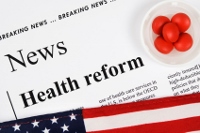
According to a January KFF poll, more than 80 percent of Americans hold a favorable view of Medicare, the federal program that provides health insurance to individuals aged 65 and older and to people under 65 with certain disabilities. Seventy-seven percent of respondents expressed favorable views of Medicaid, the joint federal-state program that covers many low-income adults and children and offers long-term care services for older adults and individuals with disabilities.
These levels of public support were by no means inevitable. As one of the programs’ architects observed, “It is difficult for many younger people today to realize how harsh many of the criticisms and arguments against these health proposals were.”
THE MID-20TH CENTURY CONTEXT
Historians continue to debate whether Americans were inherently disinclined to view healthcare as a public good or whether that perspective developed as a result of the rise of employment-based insurance during the first half of the 20th century. Setting aside questions of causation, by the 1950s, many Americans saw health insurance primarily as a workplace benefit. In general, they were less receptive to government-directed healthcare models than citizens in many other Western nations. Skepticism toward public provision of care extended even to services for World War II veterans: while there was broad agreement that veterans were entitled to free treatment for service-connected disabilities, the country remained divided over whether the Veterans Administration should also provide more comprehensive coverage for non-service-related needs.
An emphasis on employer-sponsored coverage, combined with skepticism toward government programs, left large segments of the population—particularly retired and older Americans—without health insurance or reliable access to medical care.
By 1950, approximately 12.3 million Americans were aged 65 and older. Although the federal government did not formally begin measuring poverty until 1959, retrospective estimates suggest that more than one in three older adults lived in poverty throughout the 1950s. While this population qualified for monthly benefits under the Social Security Act of 1935, those payments often fell short of covering basic living expenses. A 1952 House Ways and Means Committee report noted that Social Security benefits were “almost entirely used to procure the bare essentials of existence.”
Older Americans not only had limited incomes, they also faced greater healthcare needs than the general population. A 1953–54 survey of nursing homes found that 90% of residents were aged 65 or older, many requiring significant assistance or long-term care. Hospital costs doubled over the decade, driven in part by advances in medical technology that, while improving outcomes, substantially increased the cost of treatment. Yet by the end of the 1950s, few older adults had any form of private health insurance. Many relied on family members, charitable institutions, or public assistance to obtain care. Others simply went without.
PRESIDENTIAL LEADERSHIP AND EARLY MOMENTUM
President Harry S. Truman, a longstanding advocate for national health insurance, directed his administration’s efforts to assess and address the unmet health and financial needs of older Americans. In its 1952 Annual Report, the Social Security Administration identified significant gaps in support and recommended establishing a health insurance program for Social Security beneficiaries. That same year, the President’s Commission on the Health Needs of the Nation, convened by Truman in December 1951, offered a similar recommendation, emphasizing the urgency of expanding access to care for the aging population.
CONGRESSIONAL BATTLES, ADVOCACY, AND COMPROMISE
Despite growing recognition of these needs, national health insurance legislation made little headway during the 1950s. Conservative lawmakers and private insurers regularly opposed new proposals. Some of the most effective resistance came from the American Medical Association (AMA), which framed government involvement in healthcare as a threat to the physician-patient relationship and a step toward “socialized medicine.”
In 1957, Representative Aime Forand (D-RI) reignited the national debate with a proposal to provide hospital insurance for Social Security beneficiaries. Though the bill stalled in committee, it galvanized organized labor, senior advocates, and progressive lawmakers. The AFL-CIO endorsed the measure and mounted a broad campaign to pressure Congress, framing the issue as a critical gap in the country’s social safety net.
Congress responded in 1960 with a narrower compromise: the Kerr-Mills Act. Co-sponsored by Senator Robert Kerr (D-OK) and Representative Wilbur Mills (D-AR), the legislation provided federal matching funds to states for medical assistance to low-income seniors. Although it laid important groundwork for what would become Medicaid, the program ultimately served fewer than 1% of eligible seniors and was unevenly implemented across states. Its limitations underscored the challenges of relying on a state-by-state approach to expanding access.
KENNEDY’S PUSH AND THE POLITICS OF OPPOSITION
After the shortcomings of Kerr-Mills became evident, President John F. Kennedy made health insurance for older Americans a top domestic priority. In 1962, he endorsed the King-Anderson bill, which proposed funding hospital insurance for Social Security beneficiaries through payroll taxes. The AMA mounted strong opposition, including its “Operation Coffee Cup” campaign—social gatherings where the wives of AMA members played recordings of actor Ronald Reagan warning that federal involvement in medicine could lead to “statism or socialism.” Although the bill failed in the Senate, the administration’s public engagement helped build public awareness and momentum.
JOHNSON’S BREAKTHROUGH AND THE 1965 COMPROMISE
Following Kennedy’s assassination, President Lyndon B. Johnson made healthcare legislation a centerpiece of his Great Society initiative. The 1964 election delivered large Democratic majorities in Congress, giving Johnson the leverage to advance his legislative priorities. The resulting legislation, the Social Security Amendments of 1965, reflected a carefully negotiated compromise. It established Medicare Part A to cover hospital care and Medicare Part B as a voluntary program for physician services. It also created Medicaid, a federal–state partnership to help states provide medical assistance to low-income individuals.
The inclusion of Part B—proposed by House Ways and Means Chairman Wilbur Mills—was a pivotal strategic move. By framing physician coverage as a voluntary insurance program funded through premiums rather than new taxes, Mills helped address the concerns of fiscally conservative legislators and expanded bipartisan support for the overall bill.[1]
SIGNING THE LAW AND HONORING ITS CHAMPIONS
Johnson signed the legislation into law on July 30, 1965, at the Truman Library in Independence, Missouri—a setting chosen to honor Truman’s enduring advocacy for national health insurance. In a symbolic gesture, Johnson presented the first Medicare card to the former president. He also recognized Forand’s early role in shaping the debate, stating, “I am so glad that Aime Forand is here to see it finally passed and signed—one of the first authors.”
MEDICAID’S PASSAGE: A PARALLEL BUT DISTINCT POLITICAL PATH
While Medicare captured the most public attention, the Social Security Amendments of 1965 also established Medicaid, a joint federal-state program designed to provide medical assistance to certain low-income populations. Building on the Kerr-Mills framework, Medicaid offered federal matching funds to states that chose to participate.
Its state-administered structure appealed to lawmakers skeptical of expanding federal entitlements. For many Southern Democrats and fiscal conservatives, it offered a politically viable way to expand coverage while preserving state discretion over eligibility and benefits. Though participation was optional, Medicaid rolled out quickly: 26 states had implemented programs by the end of 1966, and nearly all had joined by 1970.
IMPLEMENTATION AND EARLY IMPACT
The Medicare program officially launched on July 1, 1966—less than a year after its enactment. Concerned that demand might overwhelm capacity, President Johnson quietly authorized the use of military and veterans’ hospitals as a contingency. Yet even as Medicare enrolled approximately 19.1 million Americans in its first year, the additional beds were not needed. It took more than a decade for the admission rate to double for Medicare beneficiaries, but because of shorter lengths of stay, the number of bed days remained constant over the same period.
The federal government initially relied on private insurers serving as fiscal intermediaries and carriers to administer Medicare. This allowed the Social Security Administration’s Bureau of Health Insurance to implement the program without immediately constructing a large federal claims-processing infrastructure. The Bureau was later incorporated into the Health Care Financing Administration (HCFA), which eventually became today’s Centers for Medicare & Medicaid Services (CMS).
As of 2025, Medicare and Medicaid collectively provide health coverage to approximately 148 million Americans, with combined federal and state expenditures exceeding $1.9 trillion annually.
[1] While the inclusion of a voluntary physician insurance plan has since been characterized as a strategic move that helped secure passage of Medicare, Wilbur Cohen—whom some have called the “Father of Medicare”—later acknowledged that he had “no specific information on how or why Mr. Mills decided to include” physicians’ services as part of the final legislative package. See: Cohen, W. J. (2004). Reflections on the enactment of Medicare and Medicaid. Health Care Financing Review, 27(Suppl), 111–116. Available at: https://www.ncbi.nlm.nih.gov/pmc/articles/PMC4195078/
